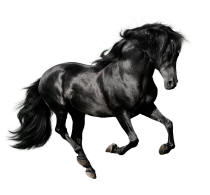Glossary

Three-Beat
Limb
An appendage to the main body of an organism.
For example, an arm, leg, flipper or wing.
The limbs of quadrupeds, such as dogs and cats, are legs.
For example, an arm, leg, flipper or wing.
The limbs of quadrupeds, such as dogs and cats, are legs.
Stride
The period of a gait from the initial ground contact of a limb to next ground contact of the same limb.
During a stride, each limb completes one step (cycle). At the completion of a stride, each limb has returned to the position it was at the start of the stride.
During a stride, each limb completes one step (cycle). At the completion of a stride, each limb has returned to the position it was at the start of the stride.
Pace
A symmetrical, relaxed gait between the walk and the trot, in which ipsilateral limbs move in unison.
Weight is transferred from one side to the other, usually resulting in a rolling motion of the body.
The pace offers faster speed than the walk, but expends less energy than a trot.
Weight is transferred from one side to the other, usually resulting in a rolling motion of the body.
The pace offers faster speed than the walk, but expends less energy than a trot.
Gait
The pattern of movement of animals during (terrestrial) locomotion.
Gaits used by cats and dogs include the walk, the amble, the pace, the trot, the canter and the gallop.
Gaits used by cats and dogs include the walk, the amble, the pace, the trot, the canter and the gallop.
Ipsilateral
Relating to the same side of the body.
For example, ipsilateral limbs are limbs that are on the same side of the body.
The pace is an ipsilateral gait because limbs on the same side of the body move in unison: the left forelimb and left hind limb move together, and then the right forelimb and right hind limb move together.
For example, ipsilateral limbs are limbs that are on the same side of the body.
The pace is an ipsilateral gait because limbs on the same side of the body move in unison: the left forelimb and left hind limb move together, and then the right forelimb and right hind limb move together.
Canter
An asymmetrical, three-beat gait in which two diagonally contralateral limbs are moved in unison, and the other two limbs are moved independently.
A typical sequence of footfalls might be right hind foot, left hind foot and right forefoot in unison, and then left forefoot.
A typical sequence of footfalls might be right hind foot, left hind foot and right forefoot in unison, and then left forefoot.
Title7
text
Title8
text
Title9
text
hover over shaded words to reveal more
Beats
Number of times that a limb, or more than one limb (in unison), make contact with the ground during one stride.
For example, a pace is described as a two-beat gait because ipsilateral limbs move simultaneously, resulting in two beats during each stride.
In contrast, a canter is a three-beat gait because two limbs move together, but the other two move independently from each other, resulting in three beats during each stride.






